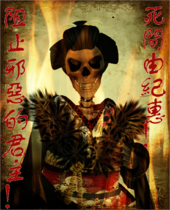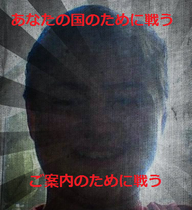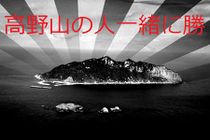Shikaeshi War
| Shikaeshi War | |||||||
|---|---|---|---|---|---|---|---|
 A supportive Lomellina propaganda showing the Beiwanese warrior on the left and the Lomellinian knight on the right provoking fear in Empress Yukie. | |||||||
| |||||||
| Belligerents | |||||||
|
With Collaborator support |
| ||||||
| Strength | |||||||
|
| |||||||
The Shikaeshi War was a conflict fought primarily between the Imperial State of Shurigawa with the Fascist Republic of Okinoshima and the Greater Beiwanese Empire from 26 August 2014. Beiwan fought Shurigawa with help from the Principality of Lomellina and Republic of Koya. The Shikaeshi War was the largest micronational East Asian war in the 21st century. The war was the result of the Imperialist Beiwanese policy aiming to dominate Shurigawa politically and militarily.
Course of the war
Shurigawa's illegal claim of Pipa Island
Before the war started, Shurigawa illegally claimed Pipa Island from Beiwan. Robert Zhang (Beiwanese Prime Minister until 3 September 2014) ordered imperial troops from Beiwan to retake Pipa Island, Shurigawan generals were arrested by the Beiwanese government.[1]


Attack on Kogajajima
As a revenge, Robert Zhang ordered the Imperial Military from Beiwan to invade Kogajajima, this course caused the beginning of the Shikaeshi War. Emperor Liu-kuang addressed to the Greater Beiwanese Empire with a speech on the declaration of war on Shurigawa. On Kogajajima there was not one soldier securing the island, Kogajajima was then ceded to Beiwan.
Surrender of Shurigawa
On 6 July 2014, Shurigawan Empress Yukie ordered to surrender to the Imperial Beiwanese Military. Two days later, Empress Yukie was forced to abdicate but she was allowed to live in the Imperial Castle. By order of the Beiwanese Emperor, the Imperial Castle of Shurigawa was forbidden for Beiwanese troops to enter. Shurigawa was ceded to the Greater Beiwanese Empire as the Occupation of Shurigawa, with the former Beiwanese Prime Minister Robert Zhang as Shurigawa's first governor.
Full attack on Okinoshima
Once Shurigawa was ceded to Beiwan Prime Minister Barbara Zhang ordered the rest of the troops to attack Okinoshima, but she left few of Beiwanese troops in Shurigawa.Supported by Koyan troops and partisans who occupied the south of Okinoshima.[2]
Surrender of Jo-Chi
On 9 September 2014, the Guide of the Okinoshiman Republic, Jo-Chi, who was then in Sanyo near te Northren Coast, issued a proclamation about his plan to transfer power and appointing Hideki Kazuo, the Prime Minister, as his successor. This was done in accordance with the Keizu Proclaimation which provided as follows: I your guide must retreat from politics before i get arrested we will fight until the surrender the capital will replaced by Izuwana and you new guide with leads us to victory is Hideki Kazuo, Jo-Chi exiled to The Netherlands. Barbara Zhang overheard that Jo-Chi was hiding from getting arrested by being in exile, she yelled in the House of Commons "Jo-Chi can hide where ever he wants but that prick of a dictator will NOT get away with war crimes, he must be arrested and punished by Heaven!"
Surrender of Okinoshima, end of the war
After the surrender of the rest of Okinoshima's allies, Okinoshima itself had no hope. The last guide of Okinoshima, Hideki Kazuo, ordered to surrender and to accept the Koyan occupation terms.
International reaction
Beiwanese Support
 Lomellina - The Prince of Lomellina D. Guilherme I and the Lomellinian Aristocracy members officialy supports the Great Beiwanse Empire againt the Imperial State of Shurigawa over the ilegal claim of Pipa Island on 4 September 2014.
Lomellina - The Prince of Lomellina D. Guilherme I and the Lomellinian Aristocracy members officialy supports the Great Beiwanse Empire againt the Imperial State of Shurigawa over the ilegal claim of Pipa Island on 4 September 2014.
 - Oskar I of the Empire of Austria-Hungary, condemned the government of Okinoshima and defends the actions of Beiwan in a military action that is "ridding the world of the fascist horror".
- Oskar I of the Empire of Austria-Hungary, condemned the government of Okinoshima and defends the actions of Beiwan in a military action that is "ridding the world of the fascist horror".
Shurigawan Support
Okinoshima - After the NPF formed a own state The members officialy declare war on Koya.Guide Jo-Chi says The old order faild they must come a new order we will support the Shurigawan case Death to Beiwan death to Koya
Neutral
 - The President of the Republic of Smithville realizes that Okinoshiman and Shuigawan are a threat to Pacific Territories such as parts of the Marshall Islands, Clipperton Island, Bora Bora, Rarotonga, Maui, Majuro, Guadalcanal, Sikaiana, Kanton Island, Rotuma, Pearl, and Hermes Atoll, Campbel Island, and Saipan. Smithville backs out because they wanted to be neutral.
- The President of the Republic of Smithville realizes that Okinoshiman and Shuigawan are a threat to Pacific Territories such as parts of the Marshall Islands, Clipperton Island, Bora Bora, Rarotonga, Maui, Majuro, Guadalcanal, Sikaiana, Kanton Island, Rotuma, Pearl, and Hermes Atoll, Campbel Island, and Saipan. Smithville backs out because they wanted to be neutral.
 - Republic Of Keig president Ben Gilmór on September 6 supported the Beiwan government mostly because of convincing from close ally Republic Of Smithville. Keig has not sent any soldiers but has sent aid to the ongoing war. But then declares Neutrality because they wanted peace.
- Republic Of Keig president Ben Gilmór on September 6 supported the Beiwan government mostly because of convincing from close ally Republic Of Smithville. Keig has not sent any soldiers but has sent aid to the ongoing war. But then declares Neutrality because they wanted peace.
War Propaganda
During the war, Beiwanese propaganda took various forms, including pictures. Beiwan also placed significant emphasis on atrocity propaganda as a way of mobilizing public opinion against Shurigawa. Many of Beiwanese propaganda uses words and pictures that are horrifically offensive, morbid, sick and upsetting towards Shurigawa and Okinoshima. The Beiwanese citizens where made to treat Shurigawan or Okinoshiman citizens unfair by the Beiwanese government. Teachers, doctors, shopkeepers or any public services where forced to refuse to serve, teach, help or socialize with citizens from Shurigawa or Okinoshima otherwise being arrested and accused for being a traitor. Other than offensive propaganda towards Shurigawa and Okinoshima, there also has been propaganda that advertise recruitment for the Beiwanese Army, Navy and Air Force.
-
An anti-Shurigawan propaganda showing that Empress Yukie is a symbol of death with Chinese text saying "Stop the evil monarch! Death to Yukie!" -
An Okinoshiman recruitment poster showing Jo-Chi is a symbol of peace and unity with Japanese text saying "Fight for you Country Fight for you Guide" -
Koyan Propaganda maded by Kevin Vanhaar with Japanese text saying "People of Koya to victory"


